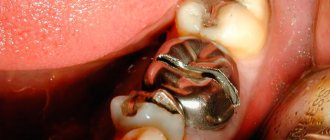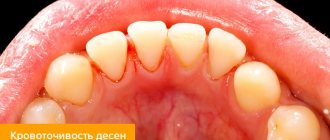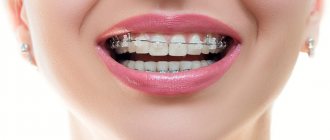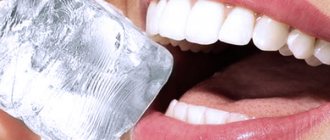Every third person experiences toothache when consuming hot and cold foods (drinks), even with careful oral care. Why do teeth react painfully to temperature changes? Is it treatable? What recommendations should you follow to avoid hypersensitivity?
The reason for the high sensitivity of teeth to various irritants (temperature, acids, etc.) is enamel hyperesthesia. It can be expressed as a short-term reaction, but more often manifests itself as a systemic disease when eating cold and hot foods.
Why do teeth hurt from cold and hot?
The most obvious causes of pain when eating cold and hot foods are:
- Regular exposure of enamel to acids
. Remember, do you eat too many lemons and oranges, do you like sweet carbonated drinks and especially Coca-Cola? - Microscopic enamel injuries
. Tiny cracks are not uncommon among those who like to chew nuts, seeds, caramels, and other hard foods. For the same reason, the habit of biting your nails and clenching your teeth is also dangerous for your teeth. - Abuse of whitening pastes
. They can be used in short courses. It’s better to seek help from professionals - home whitening does not provide a long-lasting effect, but it seriously damages the enamel. - Using a brush that is too hard
. Such a personal hygiene instrument provokes atrophy of the soft tissues of the gums and ultimately leads to exposure of the neck of the tooth. - Development of caries
. Hyperesthesia in this case signals the development of erosion and the appearance of wedge-shaped defects. - Exposure of the neck of the tooth
. There is no enamel at the base of the tooth, so patients with this problem react particularly acutely to cold and hot foods, and even to a flow of cold air when inhaled.
Body problems that, at first glance, are in no way related to dentistry can also deprive you of the pleasure of eating ice cream. These include:
- Endocrine disorders
. Problems with hormones change the acid-base balance in the mouth, which in turn affects the condition of the enamel. - Acute respiratory diseases
. Bacteria and viruses during acute respiratory viral infections, acute respiratory infections and influenza can easily provoke hyperesthesia. One thing is good: with recovery, excessive tooth sensitivity also goes away completely. - Bacterial gastritis
. Increased acidity causes heartburn, which in turn increases acidity in the mouth. A too acidic environment inevitably leads to the destruction of enamel and the development of hyperesthesia. - Stress
. When we worry about problems in the family or at work, we unconsciously trigger a complex mechanism, one of the manifestations of which is increased nervous excitability. They respond with excessive sensitivity to global stress and nerve roots in the tooth. - Lack of magnesium, calcium or phosphorus
. Without getting enough of these minerals, tooth enamel begins to break down, nerves become exposed, and sensitivity to the temperature of food and drinks increases. - Toxicosis during pregnancy
. The first trimester is a difficult period during which a woman often develops stomatitis and periodontal disease, and all dental problems, including hyperesthesia, worsen.
Some medications, such as hormonal contraceptives, can also cause problems. As well as constant inhalation of chemicals, which is typical for workers in the food and chemical industries. Situations in which teeth react only to hot or only to cold deserve special attention.
A painful reaction only to hot foods is most often a sign of an exposed nerve. By the time pain appears, the culprit tooth is already practically dead due to lack of tissue nutrition. But decomposition inside the tooth is in full swing with the simultaneous release of methane gas. When eating hot food, methane expands and puts pressure not only on the inflamed nerve, but also on the main one, passing through the entire dentition. Thus, due to the disease of one tooth, hyperesthesia of the entire jaw can develop.
The cause of tooth sensitivity to cold foods, drinks and even air often lies in inflammation of the soft tissues of the tooth - pulpitis. And also in the exposure of the neck: in those areas that react to cold, you can usually easily see the peeling of the gums from the neck of the tooth.
Why do teeth react to heat?
There are many causes of hyperesthesia, and not all of them are obvious upon a quick examination.
- Caries. Indeed, it can be the culprit of pain. But, as a rule, in this case we are not talking about a superficial lesion, but about large carious cavities hidden under the gum, in the area of the neck of the tooth. Sometimes a dental examination is not enough to detect them; the problem can only be identified with the help of an x-ray.
- Newly installed filling. If your tooth begins to react to heat for the first time after visiting the dentist, there is no need to sound the alarm. Normally, after a few days, the gum microtraumas will heal and the tooth enamel will be restored.
- Other dental interventions. Increased tooth sensitivity for several days after cleaning or whitening is an absolute norm and does not require dental intervention. A reaction to heat will definitely occur after tooth preparation, for example, before installing veneers or crowns. Unpleasant sensations from hot tea are guaranteed in the first days after the removal of a gum pocket over a wisdom tooth or any other procedure that traumatized the gums.
- In 83% of cases, the tooth aches due to a non-carious lesion, for example, a wedge-shaped defect or pathological abrasion of the enamel. Such conditions progress quickly, but are difficult to treat. That is why, given the prevalence of the problem, at the first cases of discomfort caused by hot food, you should urgently consult a dentist.
- Increased tooth wear. Normally, the process of enamel abrasion is almost invisible. With pathology, by the age of 35-40, the length of the visible part of the tooth can decrease by 30-50%. Moreover, the process, as a rule, affects all teeth, without exception. There are several reasons for increased abrasion: bruxism, prolonged and frequent chewing of solid foods, straight bite, exposure to chemicals. For example, for workers involved in the production of inorganic acids, increased enamel abrasion is an inevitable occupational disease.
- Cervical wedge-shaped defect. In adulthood and old age, more often, a kind of step may form at the neck of the canines and premolars. It is not as harmless as it might seem at first glance. At first, the defect will make itself felt only by a slight reaction to hot foods, but later it can lead to chipping of the entire coronal part. The cause of the disease is not completely clear, but many dentists are convinced that the whole issue is due to many years of improper oral care, namely, too harsh brushing of teeth.
- Erosion of enamel. This type of non-carious tooth damage is more common among young patients under the age of 30-35 years. At first, the enamel is covered with whitish spots, which over time acquire a yellow and then a brown tint.
Erosion can be caused by:
- external factors: excessive consumption of sweets, juices, carbonated drinks, addiction to aggressive whitening agents, wearing braces;
- internal causes: reflux of gastric juice into the esophagus due to reflux disease, regular induction of vomiting with anorexia, and even banal heartburn, which recurs too often;
At least 10% of all cases of hyperesthesia are caused by other dental pathologies. The dentist can identify them during a conversation with the patient and during an examination.
- Microcracks in enamel. In the most advanced cases, even the patient himself in the mirror can see longitudinal stripes crossing the entire surface of the tooth. At the initial stage, digital transillumination will help detect the problem. In a darkened room exposed to ultraviolet rays, healthy enamel emits a blue glow, while the affected areas remain darkened. Microcracks appear as a result of the habit of cracking seeds, love of hard nuts and candies.
- Recession (recession) of the gums. This is a pathology in which the gum gradually drops below the enamel-cementum border, exposing the neck of the tooth. The latter remains absolutely defenseless against any influences, including hot food. Sometimes recession develops as an independent disease due to the congenital thin gum biotype or age. But more often, prolapse is a consequence of periodontal disease.
Sometimes, during an examination, the doctor does not detect any dental problem, but the patient cannot even eat a spoonful of hot soup without pain. In this case, the problem will have to be looked for by involving doctors of other profiles: a neurologist and endocrinologist, a gynecologist and gastroenterologist, a pediatrician and an immunologist. It is these specialists who are able to identify the cause of hyperesthesia caused by systemic disorders in the body.
- Pregnancy. While expecting a baby, many women face the problem of increased tooth sensitivity. In this case, it is likely that the dentist will not detect any pathological changes in the enamel or gum disease. Healthy teeth hurt due to a hormonal storm in the body, and a woman can only do one thing: be patient and wait. As a rule, 12-18 months after birth, hyperesthesia goes away on its own.
- Endocrine disorders. Any problems in the hormonal system can increase acidity in the oral cavity. And this in turn entails an increase in the sensitivity of the enamel.
- Lack of vitamins and minerals. A lack of calcium, magnesium and phosphorus is especially destructive to gums and tooth enamel. For better absorption, they should be taken together with vitamins: phosphorus and calcium with vitamin D, magnesium - in the form of a chelate or gluconate in combination with vitamins B6, C and D.
- Chronic stress. With prolonged emotional overload, the nerve endings, including those in the dental pulp, become so sensitive that they react to the slightest discomfort.
- Exposure to chemicals. Moreover, medications and increased levels of aggressive substances in drinking water, air, and food can be detrimental to tooth enamel.
Medications that can cause hyperesthesia include:
- aspirin;
- tetracycline;
- oral contraceptives;
- other hormonal drugs;
- diuretics;
- cough syrups.
Only one tooth or all of them may experience discomfort when eating hot food. And this fact often suggests the cause of the pain. So, a problem with one tooth is more likely to indicate a mechanical injury. Damage to several teeth located next to or symmetrically to each other indicates increased abrasion.
In a generalized form of hyperesthesia, when the entire oral cavity is affected, we can almost certainly talk about systemic problems in the body: hormonal imbalance, metabolism, problems with the gastrointestinal tract.
Pain after dental treatment
Sometimes the start for the development of hyperesthesia is a visit to the dentist. The doctors themselves admit: the insufficient level of professionalism is entirely to blame for the development of this situation. Teeth may hurt after:
- hygienic cleaning and polishing;
- whitening procedures;
- installation of a photopolymer filling;
- tooth extension, or rather, due to etching of tissues with acid-containing gels.
In the vast majority of cases, an experienced dentist would be able to avoid the development of hyperesthesia. For example, a whitening service in modern clinics necessarily includes a preventive procedure for protecting the enamel. And the development of tooth sensitivity after filling indicates a gross mistake by the doctor. Possibly during treatment:
- not all inflamed tissue was removed by the dentist;
- a burn of the pulp occurred, and as a result, inflammation developed;
- an air bubble remains in the treated cavity;
- the doctor damaged the integrity of the seal;
- individual intolerance to the composite material made itself felt.
Unfortunately, the pain will not subside over time, but will only intensify. Therefore, if the sensitivity of tooth enamel remains unchanged for 7-10 days, it is better to schedule an examination with the dentist again. If the pain increases, you cannot postpone the visit: you need to see a doctor as soon as possible.
What to do if your tooth hurts?
A toothache is a good reason to visit the dentist as soon as possible.
During your visit to the doctor, the following factors will be important:
- when the pain appears, how intense is it, does only the tooth hurt or the pain spreads to neighboring areas and affects other parts of the face;
- other symptoms that appeared simultaneously with the pain, joined later or preceded its appearance;
- previous dental treatment and the time frame in which it was performed.
You can also use all these factors for self-diagnosis in order to provide yourself with the necessary help in cases where there is no way to urgently see a doctor.
Why does a tooth without a nerve hurt from cold and hot?
It is generally accepted that after the nerve is removed, the tooth will no longer be able to hurt. In fact, the reaction of a dead tooth to temperature is rather normal, and there is no need to worry. Over time, the pain will subside on its own, because most often the cause lies in microtraumas to the enamel of neighboring teeth that were received during treatment.
If after a few days the reaction to hot or cold does not decrease, but intensifies, you should not hesitate! It is likely that the dentist did not completely remove the nerve, and the inflammatory process was not stopped. Such mistakes are extremely rarely made by dentists with extensive experience, but among beginners it is not at all uncommon.
There is no point in blaming the aesculapians: what we are accustomed to calling a nerve is, in fact, a branched system of tiny hairs, spreading in all directions of the tooth. It is sometimes impossible to see all the “tentacles” even on an x-ray. And only with experience comes an intuitive feeling of how the “labyrinth” of nerves is located in a particular patient.
In the practice of Western dentistry, a separate specialty has long been distinguished: an endodontist, a specialist in root canal treatment. In Russia, only large, well-equipped clinics can afford specialists of such a narrow profile.
What is periostitis and how does it develop?
Periostitis (flux) is an inflammation of the periosteum - the tissue covering the bones of the upper and lower jaw. The inflammatory process in this case usually proceeds very intensely: a large amount of pus is formed, the patient’s well-being is disturbed, and a significant rise in body temperature may be observed.
- The pain in this case is intense and can be bursting, throbbing or tearing.
- Upon examination, the gums of the diseased tooth are inflamed, swollen, and painful when pressed. The swelling extends to the cheek and can be so severe that the face becomes asymmetrical.
- On the mucous membrane of the cheek in the immediate vicinity of the diseased tooth there may be a swelling with a hole for the release of pus. If there are no ways for the outflow of pus to the outside, then it can break into the soft tissues of the cheek and neck, posing a threat to the health and life of the patient.
Tooth hurts from hot or cold
There are many situations when teeth become hypersensitive to food temperature. Let's consider the main ones:
- new crown or filling;
- dentinal sensitivity;
- enamel damage.
How exactly does pain occur?
To understand the mechanism of pain when eating cold or hot food, it is enough to remember the structure of the tooth. We call the topmost, visible layer enamel. This is the most durable tissue of the human body, which reliably protects the more sensitive tooth tissues from any irritants, including thermal ones.
But if you neglect your health or due to chronic diseases, the enamel becomes thinner, exposing dentin. It, in turn, is permeated through and through with hollow tubules, which begin at the pulp itself. And without a barrier in the form of durable enamel, irritants: cold air, cold and hot drinks easily pass through the tubules of the dentin and begin to directly affect the nerve endings. The patient experiences a sharp attack of pain.
Clinical manifestations
The main symptoms of hyperesthesia are short-term acute pain in response to various irritating factors. At the initial stage of the disease, discomfort occurs when touched or exposed to cold air. If you ignore the symptoms, your teeth begin to react to spicy, hot and too chilled foods, including drinks.
The development of the process is characterized by rapidity, and later the unpleasant sensations are accompanied by a sharp pain syndrome and a feeling of soreness under the influence of a chemical, mechanical or temperature stimulus. In some cases, there is increased salivation and difficulty speaking. The attacks are characterized by suddenness and transience, after which the tooth calms down.
Due to pain, in some cases it becomes impossible to carry out hygienic procedures, which leads to the formation of plaque and mineralized deposits, increasing the risk of developing caries. Against the background of increased sensitivity, the growth of gum tissue develops, which, in turn, increases symptoms.
Forms and degrees of hyperesthesia
Most often, hyperesthesia is of a generalized nature, when the entire dentition reacts equally to cold and hot. This form of the disease is associated with a general deterioration in health or with a passion for whitening procedures. But after treatment at the dentist or injury, a localized form of the disease may occur. It captures only one tooth, less often – several.
Hyperesthesia develops gradually:
1st degree
. Often ignored by patients who are in no hurry to pay attention to the reaction of the tooth when it comes into contact with hot and cold. At this stage, brushing your teeth and eating foods with a bright taste does not yet cause discomfort.
II degree
. The irritants in the form of extreme temperatures are accompanied by tastes: sweet, salty, spicy. And the unpleasant, but still painless reaction is replaced by pain when eating.
III degree
. Now, it seems that the teeth react with unbearable pain to literally everything: hot and cold, spicy and sweet, sour and salty. And just the thought of using a toothbrush plunges the patient into horror: touching the teeth hurts even with a finger.
When erosive processes are slowed down, for example, due to the use of high-quality toothpaste or when adjusting the diet, tooth sensitivity can significantly decrease. But as soon as the underlying disease worsens or medications are resumed, hyperesthesia reasserts itself.
Tooth reacts to heat after filling
Dental treatment uses a huge range of effects on tooth tissue. And a reaction to hot food after visiting a doctor is a common situation. Even a dead tooth, from which the nerve and pulp have been completely removed, can react to temperature. Normally, within a few days, maximum 2 weeks, the discomfort will completely disappear.
But in some cases, the pain in a filled tooth not only does not subside, but also becomes stronger. There may be several reasons for this:
- not all affected tissue was removed;
- the doctor did not follow the filling technology and the integrity of the filling was damaged;
- there is an air bubble under the filling;
- the pulp burn provoked inflammation of the soft tissues;
- Individual intolerance to the filling material manifested itself.
For the same reasons, hot teeth also hurt. Most likely, the canal was treated poorly. Or the doctor simply removed one canal and did not find the second. This situation is very common when treating anterior teeth. Often, even on their x-rays, 2 channels look like one. In any case, only a dentist can identify and eliminate problems in an already healed tooth.
An overreaction to hot drinks after a whitening procedure is a clear sign of low professionalism of the dentist. In clinics that value their reputation, after whitening, teeth are coated with a protective composition with a high calcium content. And at the slightest manifestation of hyperesthesia, the patient will simply be denied such aggressive intervention, and will be recommended a more gentle method of creating a Hollywood smile.
What can you do to relieve pain?
If the pain is severe and it is impossible to get to the dentist in the next few days, hyperesthesia can be pacified for a short time. The simplest, but, alas, not always effective way is to rinse your mouth with a soda solution: 1 teaspoon of soda per glass of warm water.
Painkillers based on ketoprofen: “Ketonal”, “Flexen” and ibuprofen: “Nurofen”, “MIG” relieve symptoms of hyperesthesia well. They act quickly and allow you to completely forget about pain for 5-6 hours.
Local anesthetics in the form of gels give an even stronger effect: “Cholisal”, “Kamistad”, “Dentinox”. These drugs contain lidocaine, so they begin to act instantly. The effect, however, does not last long - for 2-3 hours, after which you can apply another drop of the product to the surface of the teeth.
Traditional medicine gives its own recipe for pain relief: rinsing the mouth with warm water with the addition of 3-4 drops of clove oil or tea tree oil.
Treatment of hyperesthesia
Clinical methods for reducing tooth sensitivity are varied and are selected individually depending on the general condition of the patient’s body and the causes of pathological changes. The doctors at the Atlantis Dental dental clinic have innovative treatment methods and pharmaceuticals in their arsenal.
- In all cases, comprehensive preventive care (professional hygiene) is indicated, including removal of soft plaque and hard deposits (stones), anti-inflammatory therapy, and selection of hygiene products for home oral care.
- When foci of caries are identified, the tooth is filled, which helps protect sensitive tissues from external irritants.
- In case of exposure of the neck, the edge of the gum is raised to the required level using surgical methods.
- For mild hyperesthesia, the enamel is treated with fluoride-containing varnishes and gels.
- For malocclusions and a tendency for teeth to wear out, orthodontic treatment is indicated.
- In some cases, electrophoresis with 2% sodium solution is effective.
We also offer an advanced technology for the treatment of hyperesthesia, which consists of blocking the dentinal tubules. For these purposes, preparations with fluorine, calcium and magnesium ions are used. When they are applied to a tooth, the enamel becomes denser, as well as obturation (blockage) of the dentinal tubules.
Is it possible to cure sensitivity on your own?
If the process is not too advanced, you can cope with hyperesthesia at home. First, you should review your diet and remove from it all those foods that cause pain: sour fruits and juices, hot drinks and dishes, iced cocktails and soda, sweets and ice cream. This alone can soothe aching teeth for a long time.
To speed up the process, you can purchase special gels and ointments, for example, Fluokal, GS Tooth Mousse, President. Their task is to create a thin film on the surface of the tooth that will protect the enamel from destruction by acids and close the exposed dentin tubules. The dental film Diplen Denta F also showed good results. It is fixed on the teeth for 7-8 hours so that the film has time to saturate the enamel with fluoride.
An excellent folk remedy for tooth sensitivity is tea tree oil. To treat hyperesthesia, 3 drops of it should be diluted in a glass of warm water and rinsed 1-2 times a day. After such rinses, it is important not to eat for 1.5-2 hours.
Self-treatment of tooth sensitivity can be quite effective. But only if the cause of the problem is thinning of the enamel. If the measures taken do not produce any results over the course of several days, and the pain intensifies, you should immediately consult a doctor.
Choosing toothpaste
For increased tooth sensitivity, desensitizing pastes containing a lot of fluorine, potassium and calcium are recommended. In addition, they contain components that fill microcracks in the enamel and restore its structure. Sometimes the composition contains a long-acting anesthetic. Such pastes can simply be spread on the teeth to get a quick pain-relieving effect.
The best on the Russian market are SILCA Complete Sensitive and LACALUT Extra Sensitive, Sensodyne F and Blendamed Pro-Expert. The popularity of these products has played a cruel joke on them - there are a huge number of fakes on store shelves. Therefore, you need to buy medicinal paste only at the pharmacy.
Despite the fact that the use of desensitizing pastes is no different from the use of conventional ones, the former are classified as medicinal. Therefore, you cannot use them constantly, without a break: a course of 4-5 weeks is enough, after which you need to return to regular hygienic toothpaste.
In order for the components of the medicinal paste to bring maximum benefit, you need to brush your teeth with special care, and for at least 3-5 minutes 2 times a day. Brushes for hyperesthesia should be selected with medium hardness. So that they can successfully cope with the removal of food debris, but cannot injure the gums.
15% discount on emergency care for acute pain!
Moscow
Diagnosis of the disease
The main diagnostic criterion for pathology is the presence or absence of hyperesthesia in the area of non-carious lesions. Most often, increased sensitivity occurs against the background of wedge-shaped defects in the cervical region. In this case, upon careful examination, an apparently healthy tooth turns out to be affected by erosion; necrosis, enamel chipping, and premature abrasion are also detected.
At the Atlantis Dental clinic, to obtain a complete clinical picture of the causes of hyperesthesia, they are guided by a complete examination algorithm:
- detection of enamel microcracks using optical systems, which allows diagnosing clinical changes in hard tissues at an early stage;
- the reaction to chemical stimuli is determined by probing with a solution of glucose, hydrochloric and citric acid;
- thermal diagnostics (test for hot and cold) is carried out by irrigation using a syringe or an air stream in different directions;
- To identify demineralized areas, clinic doctors use a low-power laser.
As a result of diagnostic measures, the severity, prevalence and localization of hyperesthesia are revealed.
The appointment includes consultation and drawing up a treatment plan with cost determination
sign up for a free consultation
Not ready for an in-person consultation with a doctor? Ask your question by phone
Treatment in the clinic
Advanced cases of hyperesthesia require the intervention of a dental therapist. Its main task is to identify the cause of increased sensitivity. And based on this, solve the problem:
- if sensitivity occurs as a result of caries , the affected tooth is filled;
- in case of severe receding gums , the soft tissues are surgically raised to the proper level;
- if the gums are inflamed , the patient will be offered medication;
- In case of severe tooth wear, an orthodontist consultation is indicated.
The initial stage of hyperesthesia is perfectly treatable with fluoridation. It consists of applying calcium and fluoride salts to damaged teeth. Usually, after 5-7 sessions the patient feels much better, and after 10-15 procedures the hyperesthesia completely subsides.
Unfortunately, if you do not adhere to a gentle diet and do not follow the dentist’s recommendations, enamel sensitivity may return after six months to a year. And the course of treatment will have to be repeated.
Iontophoresis helps enhance the effect of fluoridation. This is a physiotherapeutic method, which consists of introducing therapeutic solutions into tooth tissue using numerous but small discharges of galvanic current.
Methods to combat hyperesthesia
First you need to diagnose and determine the cause. To do this, the doctor examines the oral cavity and sends the patient for x-ray diagnostics. Having a complete clinical picture in hand, the dentist makes a diagnosis and prescribes appropriate treatment.
If the cause is thinning of the enamel as a result of hormonal imbalances, systemic diseases or, for example, non-carious processes, then the doctor prescribes a fluoridation procedure and a course of remineralization. Teeth are coated with concentrated fluoride-containing compounds, calcium and other beneficial minerals. They nourish hard tissues, making them denser and stronger, which reduces sensitivity. If necessary, restoration of crowns with composite materials is carried out.
Fluoridation will help strengthen tooth enamel
When the cause is a dental disease, further treatment tactics will directly depend on the characteristics of the specific pathological process:
- caries - a specialist removes the affected tissue, cleans and disinfects the cavity, and then fills it with a self-hardening photopolymer. This filling material hardens instantly under the light of a polymerization lamp, so it is applied in layers, where each new layer is illuminated by UV rays,
- pulpitis – advanced caries often leads to inflammation of the neurovascular bundle. Another reason may be injury to the tooth as a result of a blow or fall. Pulpitis provokes sharp and severe pain, and its treatment most often requires partial or complete amputation of the nerve, subsequent filling of the canals, installation of a pin or stump on which the restoration or crown will be attached,
- cyst or granuloma - such phenomena are usually discovered in the later stages, when surgical methods have to be resorted to to excise the pathological focus. Sometimes, along with the cyst, it is necessary to remove part of the affected root, that is, to resection its apex. In the most advanced cases, the tooth is completely removed and a crown on an implant or a bridge is installed in its place.
If you have a reaction to temperature changes in food and drinks, you cannot hesitate - you need to see a doctor as soon as possible and undergo appropriate diagnostics. The sooner you deal with the problem, the lower the likelihood of encountering complications.
What complications may arise?
The main thing to remember is that tooth sensitivity does not go away on its own. If you do not fight it, the disease will progress quickly. Unpleasant sensations will soon be replaced by outbreaks of pain when the enamel is irritated by hot and cold drinks. Then you will not be able to eat sweet and sour, salty and spicy. And at the last stage, short-term pain transforms into constant pain, and its intensity will be such that just touching the tooth will seem unbearable.
At the last stage of the disease, fluoridation will no longer help. It will be lucky if the dentist agrees to cover the patient’s own enamel with composite materials. But in most cases, the doctor will insist on the removal of diseased teeth and subsequent prosthetics.
Tooth hurts when biting
Pain in the tooth that appears when pressing and biting food indicates the development of periodontitis. The periodontium is the tissue that surrounds the root of the tooth and holds the tooth in the jaw.
Periodontitis can be acute, or it can have a chronic, practically asymptomatic course. In any case, if you suspect periodontitis, you should consult a doctor and undergo the necessary treatment. If this is not done, then over time the teeth begin to loosen and fall out.
- If the process is acute, then the pain when pressing and biting can be intense and be accompanied by other symptoms, such as pain in the area of the tooth and the adjacent area of the gum, the sensation of an “overgrown tooth,” inflammation and suppuration of the gum tissue with the formation of gumboil.
- A chronic process can make itself felt only occasionally through unexpressed discomfort when biting. The appearance of pain and discomfort will indicate an exacerbation of the process, which in most cases is observed with a decrease in immunity.
Prevention of tooth sensitivity
The best prevention of hyperesthesia is daily care of tooth enamel:
- Thorough brushing of teeth 2 times a day.
- Periodic use of preventive pastes and complete avoidance of bleaching products containing abrasives.
- Mandatory presence in the diet of foods containing calcium and phosphorus.
- Minimum consumption of sweets.
- The habit of drinking juices and carbonated drinks through a straw.
- Avoiding foods that are too hot or too cold.
And most importantly: if the tooth’s reaction to an irritant occurs abruptly, and the painful sensations do not go away within 3-4 days, contact an experienced dentist. Don't wait for the problem to become rampant.
Author: Elena Grunina Dentist-therapist, endodontist. Work experience more than 9 years.
The information is for reference only. Before treatment, consultation with a doctor is necessary.
How to prevent tooth pain?
The main rule for preventing discomfort and dental hyperesthesia is regular visits to the dentist. This way, the doctor will be able to promptly notice any diseases and prescribe the necessary treatment. You also need to follow a number of constant rules that will minimize the possibility of pain.
- Maintain good oral hygiene. This concept includes regular brushing of teeth and timely replacement of a toothbrush, use of dental floss and rinsing. When choosing a brush, pay special attention to its hardness - it should not injure the enamel, but should gently but effectively remove plaque.
- Limit the use of whitening pastes, as most of them harm tooth enamel. If you want to have a radiant smile, it is better to go to the clinic and have professional teeth whitening.
- Watch your diet - eat more fruits and foods that contain minerals that are vital for the health of your teeth.











